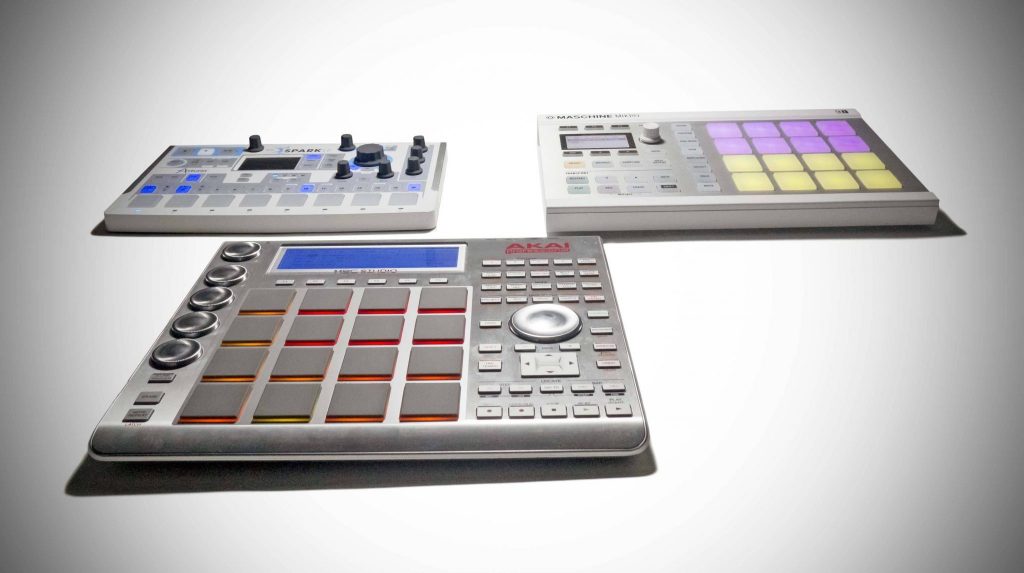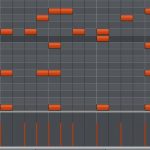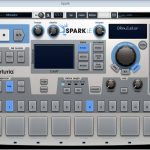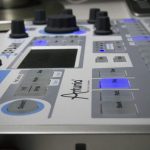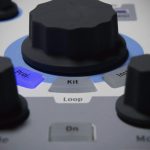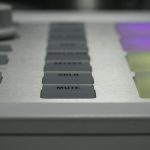Jump To: MPC Studio | Maschine Mikro | SparkLE | Summary
A DJ Isn’t Just a DJ Anymore
The last decade has brought a huge change in how DJs perform. Many still mix two tracks all night long, but a lot of DJs are starting to integrate original works into their sets. We are seeing live mashups, integration of original pieces, and live remixing stems. Most of us have our software of choice and have to deal with the various limitations involved, but many DJs also want to start integrating tools into their rig which allow them to develop their own sound and style on top of their song selections.
There are a lot of tools of varying price, and choosing can be a very personal experience. Between deciding on the software you want to use and the hardware to use with it, the costs can become astronomical and the learning curve may be extremely steep. I have been looking for a solid tool to integrate into my rig which would allow me to develop my own beats and easily integrate them into a live performance, all at a reasonable cost under $400. The preferred solution must include a robust sound library and a powerful piece of hardware directly integrated into the software solution.
The choices I settled on were the Native Instruments Maschine Mikro MK2, the Akai Pro MPC Studio and the Arturia SparkLE. All three of these solutions offer a powerful software choice with a unique workflow, send and receive MIDI clock and can be used both to create kits for improvisational drumming and pre-arranged rhythms and sequences. Over the last few months I took an in-depth look at all three options to give a basic synopsis of what was available and how to integrate them into your rig.
We don’t want you to think that what’s below are complete reviews of these products. The Akai Pro MPC Studio was already reviewed by Markski, and there are tons of resources available around the web with more detailed looks into the Maschine and Spark software. I am going to just be looking at my experiences using these controllers as all-in-one solutions to augment my DJ rig. The rig I am using is: two Stanton Str8-150s, a Vestax PMC-05 IV Pro and an Audio6. I am using the Main Out of the Audio 6 to the Aux in of my mixer. Since I’m on Windows I also needed a virtual MIDI driver to connect Traktor and the software I was using. For this I used Bome MIDI Translator Pro as a sort of MIDI patch bay, but you can use free options like LoopBE or MIDI Yoke as well.
Also, as a note on Traktor’s MIDI clock, all products suffered from some drift when synced to the Master Clock while using turntables. This can be rectified if you keep a static tempo in Traktor and don’t use the individual decks as your master. I don’t like doing this, but it is the most reliable way to sync external audio to your performance.
Akai Professional MPC Studio
Link: Akai Pro | Price: $399 /€349 /£299 | Manual: PDF
- 7+ GB of sounds
- Supports VSTs
- 8 Banks of 16 RGB MPC Pads
- Four touch sensitive knobs
- Large LCD Screen
First on my list was the Akai Professional MPC Studio. Akai Pro has a well-known, established, time-tested brand that DJs and producers respect and trust. The MPC Studio is one of Akai Pro’s first serious entries into computer based music production. Historically, the MPC line of grooveboxes has a luxury brand, held to a very high professional standard and used by some of the most successful producers. The Studio, is a lower cost solution with the same standard MPC standard and including a newly revamped software.
Where the MPC Studio stands apart from almost every other solution is the seamless integration between the hardware and software. While the Maschine Mikro MK2 has very powerful integration, the large LCD screen on the Studio provides more information, and there almost every menu and command is accessible directly from the controller. The amount of controls, however, offer a blessing and a curse. It’s great that there is access to so much but if you are not accustomed to their workflow it can be extremely overwhelming at first. Since I had never used an MPC before it definitely took a bit of adjusting to figure out how to best take advantage of its workflow.
Where the MPC Studio really stands out is when you use the hardware almost exclusively. Accessing layers from the hardware is a lot easier using the buttons and navigation controls available as opposed to digging through the software. While the software is more than capable of meeting your needs it is not nearly as elegant without the hardware. If this is something you aren’t comfortable with, and your preference is for clicking with the mouse, then you might not be comfortable with the Studio. Editing patterns after you’ve laid them down is fine, but beyond that it’s much more elegant to do most of your work via the hardware.
Programming Beats
It took me a little while to find a groove (heh) drafting beats with the Studio software. Laying down a pattern is pretty much as easy as hitting record and playing, but fine tuning everything can feel a little overwhelming. Yes, just about every function of the software is easily accessible straight from the hardware, but it almost felt like I was being sent in the wrong direction if I wanted to use my mouse and keyboard.
Browsing for sounds was, by far, the most frustrating experience I had in this whole process. The MPC software doesn’t support meta-tagging yet, so I was just looking at a folder full of sounds. Yeah, the file names had the sound type (BD, SD, Tom, etc.) but digging through just the supplied sounds not pleasant. Thankfully, Akai Pro mediated this by creating both kits and collections of sounds. Unfortunately, I could only load a kit to pad bank A, and had to load individual sounds to each other pad bank one by one. That was… less than ideal.
Getting a basic drum kit from what they provided was simple enough, and starting to lay down patterns was a breeze. Once I understood the workflow of the hardware, most of the basic functions were a lot easier to get to than digging through the GUI. Putting together patterns was simple and making necessary changes was easy. Once I wanted to get to more advanced features like effects and piano rolls for tone it became a little more difficult.
As I got accustomed to the workflow and how to develop sounds I was able to dig a little deeper into the application. The provided drum kits, sound packs and individual samples went a very long way and if I felt so inclined as to add in my own created sounds it was very easy to manage. The synth sounds that came with the packs were okay but they didn’t push any boundaries. Programming the Q-Link controls for effects required digging through a LOT of layers, but once it was set up using them was very easy. I could not making changes to a kit live being an option, though, and can already recommend setting all of what you need up ahead of time. This side of the show allows for very little improvisation.
Performing Live
Getting everything set was a little frustrating, but my guess is that’s how it’s going to be for all the options below. When working with just drum sounds and not loops I wasn’t so concerned with everything staying synced. The pads felt great, and the response was really spot on. You can’t quantize each hit, but you can have it quantize your recording, so I found myself creating patterns, previewing them and then playing them out.
I did find a lot more success, though, using the step sequencer to progressively build routines while tracks were playing. This was very simple, and the LED feedback of my velocity actually made the sequences both look better to my eye, and gave me a great idea of how natural the drums would sound.
As far as more advanced tricks, I was able to drop into the piano mode and play a little melody here and there live, but it wasn’t particularly intuitive, what with all the buttons and modes and needing to do it quickly to make it count. With enough practice and a readied routine, though, this could be a very basic process. I am, unfortunately, more of an improviser when it comes to DJing. The MPC Studio and the included software lend itself very much more to plans and sets to bring out than just throwing some kits in and rocking out.
This is especially clear when dealing with effects. Navigating through the various layers and menus on the hardware, or software for that matter, to assign the Q-Link knobs to FX parameters is, for lack of a better phrase, a pain. These have to be set up ahead of time, and as I mentioned above, setting them up is rather involved. I really wish there was just a way for me to set up macros where I can select effects beneath one layer and just assign them to the next Q-Link knob in the chain.
Final Thoughts
Not having meta-tagging for sounds makes finding the right ones very difficult, and I do wish I could create multiple kits and just drop them one by one into different sound banks. There are great features buried under many layers, making it very difficult to truly improvise a set. The top few layers, though (playing, recording, browsing, etc.) are very intuitive and easy to navigate. The MPC Studio sounds great, and the pads are as good as we are going to find on the market. The software is definitely powerful as long as you are willing to prepare most of your set ahead of time.
Gallery

Arturia SparkLE
Link: Arturia | Price: $249/€249/£219 | Manual: PDF
- Does not host VSTs, but can be hosted
- Receives MIDI Clock
- 2 Banks of 8 Velocity Sensitive single color Pads
- X/Y Pad
- 3 User Assignable encoders
Compared to the other two options on this list, and most other options on the market, the Arturia SparkLE takes a different approach to design. While the MPC and the Maschine both have a classic 16 pad drum kit design, the SparkLE is set up more along the lines of the Korg Electribe or Reason’s ReDrum. There are 8 velocity sensitive LED pads along the bottom to select your sounds and 16 smaller buttons for each step of the pattern. Each step of the pattern can measure anywhere from 1/32nd beat to 1/2 beat, allowing for a pattern to range from a single step up to 32 bars.
Of the three options presented, the SparkLE is also the most minimal. It isn’t a full DAW, can’t host VSTs and won’t record your sounds. However, it is a fully functioning drum machine and step sequencer and can be loaded as a VST or be MIDI synced to your DJ app of choice.
The design of the controller is very straight forward, and I found it extremely intuitive. While there aren’t a lot of controls available, what is there is all you need for pattern creation and performance. You only have access to 8 sounds at a time, and can only access 16 sounds in a single kit, but changing kits and sounds is very easy from the controller. In fact, it’s easier from the controller than from the software. While there aren’t many effects available, accessing them is extremely simple both from the controller and the software.
As far as additional controls, there are three user assignable knobs which can control sends or parameters of individual sounds and a touch pad which can control three effects per instrument and three effects for the whole kit, though only one at a time. For the touch pad, holding each button allows you to select different ways the effects interact with your sounds. Holding the button down shows you the options on the computer screen but you can select the modes using the touch pad on the controller. I would recommend spending some time focusing on this part so you can build the muscle memory to find the effects you need in a pinch.
The GUI is intuitively designated into three sections: develop and build your drum kits and sounds on the Bottom; use the performance features and record live at the Center, as well as apply performance effects; and build your patterns and connect them into a song on the Top. After a little while playing with how it was set up I dug into designing that “signature” sound.
Programming Beats
The SparkLE comes with a lot of sounds and pre-organized kits. Each sound is organized by type (bass drum, snare drum, etc.) and organized into a kit based on both genre (Latin, Electro, Dub, etc.) and then by kit name. Every kit comes with almost every pattern of every bank filled, leaving you with a lot of pre-programmed content. Oddly, I found myself picking the sound I wanted and just clearing all of their content and saving a new kit.
Building your own kits is intensive, but finding sounds is a breeze, and if you want to customize the provided sounds then you can either add your own samples or layer sounds. Of the three solutions I looked at, I was shocked to see just how intuitive putting together HUGE kick drums and really resonant snares was. Each individual instrument can have 6 sounds stacked together, and editing each sound was a breeze. This all does need to be done on the software without assistance from the hardware, though.
The workflow for SparkLE is much more bifurcated (I had to look it up and so should you – Ed) compared to the MPC Studio. You have certain things you can only do with the software, and other things that are easier to do via the hardware. But the workflow does make sense. Use the software to build your kit, use the hardware to program it, and then use the software again to tweak and master it. Adding in automation was a breeze in the step sequencer screen, and dialing in effects to each sound and to the returns was easy as well.
Developing a signature sound with the SparkLE was very simple for a performance setup. Using it to design intense songs and really deep soundscapes is not really an option, but to put together a solid sounding kit that is unique to you which can easily be layered into your live show was shockingly simple. There were very few hoops to jump through and a lot of product available at the end.
Also, keep in mind that while there is no Piano roll in Spark, there is still a Tune mode. You can load a bass sample in, hit record while in Tune Mode and record it as if playing it on a keyboard.
Performing Live
The SparkLE comes with a large assortment of both kits and pre-arranged patterns. These patterns are, by and large, really good for almost any type of music. I took a kit I’d been working on, threw in a few extra sounds to round it out and wrote a few new patterns. Once I got the MIDI sync connected everything was off and running.
Playing the recorded patterns was just as simple as expected and navigating the various banks was even simpler. Instant access to 16 patterns was great, and it is just a single layer deep to access the remaining 48 patterns in the other three banks. Augmenting these patterns wasn’t very hard, but you do lose the velocity control that the MPC provides as a step sequencer (the 8 sound pads are velocity sensitive). You can easily create a new pattern, or clear an existing one, and punch in your steps. You do need to access the software, though, to change the key signature of the pattern, or the length of each step, but I never really felt like I needed this. How often am I going to need anything other than a 4/4 time signature and 1/16th length for each step?
The pads responded great when being played as well. They weren’t as sensitive as the MPC Studio, but they are much smaller. Having only 8 at a time felt a little weird, but for most basic work it was still more than enough. I did find myself wanting it in a 4×4 grid as opposed to a single row of 8 pads, but I adjusted quickly to the different workflow. If I got a good rhythm I could hit Record on an empty pattern, play and instantly have a new one saved. The option for quantized recording, something the MPC doesn’t offer, made this much easier.
The effects were easily accessible no matter what. While there aren’t many performance effects available, I didn’t really need much more than what was there. If I set up the parameter knobs ahead of time I had some extra controls to mess around with, but if I didn’t, and just relied upon the touch pad effects they were easy to get to and simple to use. Not having the GUI in front of me made it impossible to select the correct Filter or the Roll type effect, but having it up for just a second doesn’t take that much focus away from actively DJing.
So just like the other options, this small controller gives me access to almost everything I could need in a smaller workflow. The included sound library is more than suitable for almost any genre of music, and building kits is extremely easy.
Final Thoughts
The SparkLE is not as open-ended as the other two solutions on this list. It can’t be used as a DAW replacement and really shines when being used for more minimal functions within a larger solution. There are performance effects, but you can only quickly access the 5 on the face of the controller, or assign sends 1 and 2, and there are only three parameter knobs for each sound/send. If you are interested in really tight drum programming with a large selection of samples and really powerful hardware integration, you can’t really go wrong. If you are using it alongside a standard DJ solution it will easily carry its own weight, and if you decide to start doing more advanced work within a DAW then it can easily be integrated into your workflow.
I found working with the SparkLE very simple, and extremely intuitive. The hardware is straight forward and the software is minimal while still being elegant and powerful. Being able to quickly edit and layer sounds made creating a more signature kit much easier and more satisfying.
Gallery
Maschine Mikro
Link: Native Instruments | Price: $349 /€333 /£279 | Manual: PDF
- Hosts VST, AU and supports Rewire
- Receives and sends MIDI Clock
- 5 Drum Synths
- 8GB+ Library content
- Includes Massive, Reaktor Prism, Scarbee Mark I and Solid Bus Comp from Komplete 9
- 16 Pads and 28 Buttons, all multi-color
- Unlimited number of groups and patterns, 64 scenes available
And on to the last option on our short list, the Maschine Mikro MK2 by Native Instruments. With the release of their new software, Maschine 2.0, and announcing a few months ago bundling Massive with Maschine this application has just gotten bigger and more powerful. The controller boasts extremely tight integration with the software, as well as easy access to an almost unending amount of sounds, loops, and effects, especially when combined with Komplete 9.
While the Maschine Studio and Maschine MK2 are very powerful, the Maschine Mikro MK2 sits exactly where we want it to for this project. You still have access to all the power of the Maschine software, you are just more reliant on the software than with the two alternatives. For the price difference, though, these are easy sacrifices to make, especially if your end goal is to just produce beats for your DJ experience.
The initial dream, of course, is that since it’s a Native Instruments product we can bid a fond farewell to the MIDI sync issues of Traktor. Unfortunately, this just isn’t the case yet (here’s to hoping). There is no direct integration for Traktor within Maschine, but the design makes the transition very simple. The new software is a large change from the older 1.8, and if you haven’t upgraded I’d really recommend looking at any videos you can find. I was a bigger fan of the browser in 1.8 than I am of 2.0 thus far, but I’m sure that through the course of this project I will adjust accordingly.
The other great change to Maschine 2.0 is the removal of almost all limitations Native Instruments had placed in 1.x. There are no longer any limits on groups or patterns in a scene, though you are still limited to 64 scenes per project. This was my big complaint when using this application, and now that I can have larger, more complex projects I feel a lot more excited digging in. So let’s get started and see what we can do with our DJ sets.
Programming Beats
As a note, the removal of the limitations between Maschine 1.8 and Maschine 2.0 are pretty stellar. Unlimited groups and unlimited patterns alone should be worth the cost of the upgrade, if you haven’t yet. The Maschine Mikro MK2, however, still has all the same limitations, namely the lack of knobs on the controller, and only one small screen. While all the functionality for the pads is easily accessible through the very deep layers, not having the knobs can make things a little frustrating while creating.
The direct integration with Komplete has always been a huge selling point, and now that Maschine comes with Massive, Reaktor Prism, Drumsynths, a host of Kontakt samples and professional grade compression and effects any user can take advantage of the sounds and tools. The MPC comes with synths as well, but Akai Pro just can’t compete with the power and elegance of Massive. Creating melodies and bass lines is definitely easiest on Maschine, and creating songs is really intuitive using groups and patterns.
There has been a lot of improvement on the GUI in the past few versions, but Maschine 2.0 really gets set apart. The icons and layers are very easily accessible with both the mouse and the controller. While I preferred the older Browser, the meta-tagging provided is amazing for the included samples. Drilling down from All Samples to those individual kick drums or bass sounds is just a breeze, and building your own kits is just easy.
Creating and drawing in automation is very simple, but there are a LOT of layers to dig through to get to all the functions. While I found the GUI very intuitive, you have to be willing to deal with the modality of the software.
Programming beats by playing them or by using the step sequencer were both really simple and intuitive. I do wish that I could have either the brightness or color of the pads change based on velocity, but I didn’t even know I would have liked that until I saw it on the MPC Studio. It’s one of those little additions that really sets it apart. Regardless, recording melodies and bass lines are simple straight from the controller, as are loading samples to individual pads, or the included kits. There are included projects to get you started with pre-organized sounds and patterns, and you can clear the provided patterns to start from scratch, or begin performing with the sounds they put together.
Playing Live
As I mentioned before, I pray for the days when Maschine and Traktor are directly integrated in one direction or another. Loading Traktor into Maschine, or Maschine into Traktor à la The Bridge, will just take all of this work to a new level and probably change my end opinion on these pieces of gear. We may have to deal with the same drift issues from Traktor, but we might as well make the best of it, right?
The pads feel great when playing live routines. They are responsive, and the visual feedback on the controller is stunning. There is a real difference of style between the MPC Studio’s color feedback for velocity, and the white burst from the Maschine. Both let you know that you’ve struck the pad, but just in different ways.
If you are going to use automation or effects, then the Maschine Mikro can be disappointing. You can access parameters from the controller, but pretty much only one at a time from the endless encoder so doing anything of substance live can be a pain in the ass. You can draw what you need ahead of time for patterns, though, leaving you in a similar position as the MPC Studio.
Recording live patterns along with your sets is very simple, and using the step sequencer is very intuitive with the small onboard screen. While the screen is smaller than the MPC Studio, it manages to pack a lot of information in based on the state of the controller/software. Unfortunately you will still find yourself falling back to the software a lot more than with the other two options since there is so much more in the software yet so much less you can access via the hardware.
I found the controller powerful and the included sounds were stunning. Having access to Massive brought out a lot more sounds I didn’t really have access with and of the other options, and the new GUI gave access to so much more to build better kits for longer sets.
Final Thoughts
The Maschine Mikro MK2 is a great solution, but mainly because it gives access to an amazing application. While the hardware is integrated very intuitively, the limitations force me to fall back to the software a lot more than I had wanted to, especially while playing live. The screen is clear and the information provided is useful, but it is very small. Being able to quickly drop into a keyboard mode made playing melodies a breeze, especially compared to the other two solutions which were either buried behind layers (Studio) or barely existed (Spark).
Gallery
Summing Up
All three solutions are very powerful for the price, plain and simple. They all require different sacrifices, though. The MPC Studio is extremely powerful and carries all the hallmarks of the Akai Pro line, but its strength lies in using the hardware exclusively, as opposed to the software. The SparkLE is a little controller with a lot of onboard power. It is the only solution with easily accessible onboard effects, but while I can control the pitch of samples, it doesn’t have a piano roll. The Maschine Mikro comes with an extremely robust software, but the hardware is limited in what it can accomplish due to size restrictions. All of the controllers have good performance pads, but the SparkLE setup lends itself to more step sequencing than live performance. The Maschine and MPC both have great pads for performance as well as step sequencing.
For me, I was drawn to the SparkLE more than the others for simple drum programming. It had a whole host of sounds, great samples and it was really easy to create a customized kits from what was provided using the intuitive sound layering. For more song creation, though, the Maschine definitely was the best option for the price. Having Massive included just kind of made it an unfair comparison. The best hardware integration, though, definitely sits with the MPC Studio. I could use the controller exclusively without needing to look at my computer screen, and there was something really liberating about that.
Obviously I can’t tell you which is ”best” since they are all really damn good. For what I needed, though, I found myself coming back to the Spark. This could easily change if the Maschine gets direct integration with Traktor, or the MPC software becomes a little more intuitive. Each user, though, needs to make a conscious choice about what sacrifices they are willing to make. Any of these solutions will serve you well, you just need to be aware of where they fall short and where they shine.

